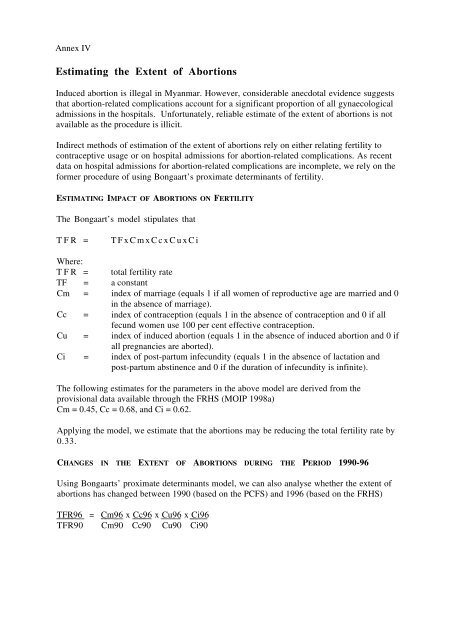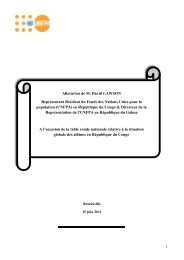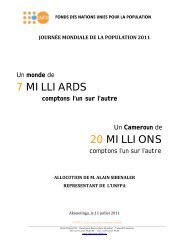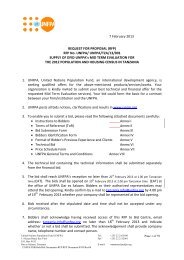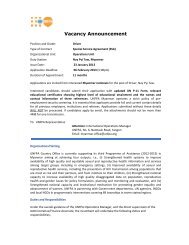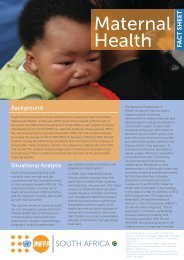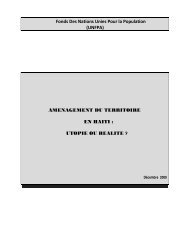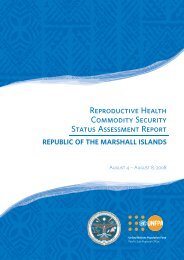A reproductive health needs assessment in Myanmar
A reproductive health needs assessment in Myanmar
A reproductive health needs assessment in Myanmar
Create successful ePaper yourself
Turn your PDF publications into a flip-book with our unique Google optimized e-Paper software.
Annex IV<br />
Estimat<strong>in</strong>g the Extent of Abortions<br />
Induced abortion is illegal <strong>in</strong> <strong>Myanmar</strong>. However, considerable anecdotal evidence suggests<br />
that abortion-related complications account for a significant proportion of all gynaecological<br />
admissions <strong>in</strong> the hospitals. Unfortunately, reliable estimate of the extent of abortions is not<br />
available as the procedure is illicit.<br />
Indirect methods of estimation of the extent of abortions rely on either relat<strong>in</strong>g fertility to<br />
contraceptive usage or on hospital admissions for abortion-related complications. As recent<br />
data on hospital admissions for abortion-related complications are <strong>in</strong>complete, we rely on the<br />
former procedure of us<strong>in</strong>g Bongaart’s proximate determ<strong>in</strong>ants of fertility.<br />
ESTIMATING IMPACT OF ABORTIONS ON FERTILITY<br />
The Bongaart’s model stipulates that<br />
TFR =<br />
Where:<br />
TFR =<br />
TF =<br />
Cm =<br />
Cc =<br />
Cu =<br />
Ci =<br />
TFxCmxCcxCuxCi<br />
total fertility rate<br />
a constant<br />
<strong>in</strong>dex of marriage (equals 1 if all women of <strong>reproductive</strong> age are married and 0<br />
<strong>in</strong> the absence of marriage).<br />
<strong>in</strong>dex of contraception (equals 1 <strong>in</strong> the absence of contraception and 0 if all<br />
fecund women use 100 per cent effective contraception.<br />
<strong>in</strong>dex of <strong>in</strong>duced abortion (equals 1 <strong>in</strong> the absence of <strong>in</strong>duced abortion and 0 if<br />
all pregnancies are aborted).<br />
<strong>in</strong>dex of post-partum <strong>in</strong>fecundity (equals 1 <strong>in</strong> the absence of lactation and<br />
post-partum abst<strong>in</strong>ence and 0 if the duration of <strong>in</strong>fecundity is <strong>in</strong>f<strong>in</strong>ite).<br />
The follow<strong>in</strong>g estimates for the parameters <strong>in</strong> the above model are derived from the<br />
provisional data available through the FRHS (MOIP 1998a)<br />
Cm = 0.45, Cc = 0.68, and Ci = 0.62.<br />
Apply<strong>in</strong>g the model, we estimate that the abortions may be reduc<strong>in</strong>g the total fertility rate by<br />
0.33.<br />
CHANGES IN THE EXTENT OF ABORTIONS DURING THE PERIOD 1990-96<br />
Us<strong>in</strong>g Bongaarts’ proximate determ<strong>in</strong>ants model, we can also analyse whether the extent of<br />
abortions has changed between 1990 (based on the PCFS) and 1996 (based on the FRHS)<br />
TFR96 = Cm96 x Cc96 x Cu96 x Ci96<br />
TFR90 Cm90 Cc90 Cu90 Ci90


